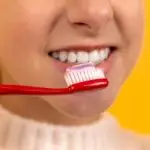
Everything You Need To Know About Whitening Your Teeth
The majority of us associate a healthy smile with self-esteem and beauty. With the smire of health comes a plethora of teeth whitening products and procedures. In this article we will help you navigate teeth whitening in attempt to break down possible myths and give you the information needed to ensure it’s done safely and effectively.
1. You should really look at why those teeth are discolored in the first place
Everyone seems to be taking care of their teeth today. Before looking into purchasing any whitening products it is extremely important to figure out why your pearly whites lost their brightness. Common causes of discoloration include the following:
- Food and Drink: Popular ‘stainers’ include coffee, tea, dark red wine or anything that is darkly colored and that can be consumable.
- Use of Tobacco: either smoking or chewing the product leads to discoloration of yellow or brown.
- Aging: Back in the day things were subpar on the dental side. Every day wear and tear makes you lose enamel resulting in exposing yellow dentin underneath.
- Poor Oral Hygiene: Unattended plaques due to low scrubbing and flossing results in hideous stains.
- Medications: Off brand antibiotics known for discoloring teeth include tetracycline and some antiallergy drugs
By finding the right information regarding the marks found on your skin ensures the most effective method can be provided for your teeth.
2. What Works: Effective Teeth Whitening Strategies
There are different options when considering whitening treatments, but their effectiveness varies. Here are the most effective and scientifically proven options to whiten your teeth:
a. In-Office Professional Whitening
- How It Works: Dentists employ potent bleaching agents (like hydrogen peroxide) and lights or lasers to expedite the whitening process.
- Results: As much as 8 shades whiter after a single session.
- Pros: Results are quick and real; a professional oversees the procedure.
- Cons: Costs can be high (more than $500); sensitivity is a possibility.
b. At-Home Whitening Kits (Recommended by Dentists)
- How It Works: Your dentist will give you custom trays along with professional-grade whitening gel, so all you have to do is apply it.
- Results: Moderate whitening in 1-2 weeks.
- Pros: Less expensive than in-office treatments and useful for average stains.
- Cons: Must be used consistently; potential for sensitivity.
c. Whitening Products Sold In Stores
- Whitening Strips: These are thin, flexible strips covered in a gel containing peroxide. They are easy to use and inexpensive.
- Toothpaste: This contains gentle abrasives and bleach in low concentrations; most effective on surface stains.
- Whitening Pens: This is better suited for touch-ups, but not as efficient against deep-set stains.
d. Natural Whitening Remedies
- A paste made of baking soda and hydrogen peroxide can lift surface stains.
Coconut or sesame oil may reduce bacteria and surface stains when swished in the mouth for 10 to 20 minutes.
Activated charcoal is effective for absorbing surface stains but can be abrasive if overused.
3. What Doesn’t Work: Common Teeth Whitening Myths
Not every whitening approach is effective. Below are some popular methods that may even be harmful instead:
a. Lemon Juice and Baking Soda
- The Myth: Lemon juice is acidic and can whiten teeth while baking soda acts as an abrasive.
- The Truth: Lemon juice will erode enamel protected teeth which will make them increasingly prone to staining and sensitivity.
b. Apple Cider Vinegar
- The myth: Apple cider vinegar can remove stains and kill bacteria.
- The Truth: Like lemon juice, its high acidity can damage enamel over time.
c. Charcoal Toothpaste
- The Myth: Activated charcoal can whiten teeth by absorbing stains.
- Truth: While it may remove some stains, charcoal toothpaste is abrasive and can damage enamel with frequent use.
d. DIY Whitening Hacks (Strawberries, Banana Peels, etc.)
- The Myth: Natural fruits can whiten teeth.
- The Truth: These methods lack reliable proof while putting enamel and gums at risk.
** 4. What’s Safe: Guidelines for Protection of Your Smile ***
* Ensure that you don’t damage your enamel or gums while whitening your teeth. Here is the right way to whiten your teeth without risks:*
A. Always See A Dentist
- Before using any whitening treatment, make sure that you visit a dentist.
B. Make Sure To Follow Directions On The Label
- When whitening your teeth using store-bought products or professional treatments, always check some guidelines that they provide on their products to avoid overuse.
C. Do Not Over-Whiten Teeth
- Sticking to recommended guidelines ensures you do not suffer from enamel erosion. Always expect some exposure sensitivity, but stick to branded guidelines for whitening.
D.* Maintain Good Oral Hygiene*
- Ensure the health of your gums by using antibacterial mouthwash. Brush your teeth two times a day, and use strings to floss.
E.* Avoid Stain-Causing Drinks And Foods*
- Cut down the amount of red wine, tea, and coffee that you consume to avoid them becoming hard to clean. If it is has been hard to refrain, then rinse your mouth with water immediately.
5. Long-Term Smile Brightening Strategies
Becoming an ongoing effort, teeth whitening requires constant care and effort. Here are effective long term approaches:
A. Maintaining Regular Dental Cleaning
Professional dental cleanings go a long way to removing plaque build-ups while ensuring your smile remains pretty.
B. Use touch up treatments
Whitening should not be limited to dental visits. Maintain your results by using whitening strips or pens every other week.
c. Quit Smoking
- Giving up tobacco use will drastically improve your oral health since it is the primary cause of your tooth discoloration.
d. Drink Through a Straw
- Avoid further staining your teeth by using a straw when drinking beverages that are known to cause discoloration.
e. Stay Hydrated
- The washing away of food particles and bacteria that can contribute to building stains is aided by drinking water.
6. When to See a Dentist
While many whitening methods are safe and effective, some cases require professional attention:
- Severe Stains: The chances of stubborn intrinsic stains responding to DIY treatment is almost zero.
- Sensitivity: Prolonged sensitivity is best addressed by your dental professional.
- Uneven Whitening: Uneven results due to irregularities of the enamel can best be treated by a dentist.
Conclusion
The appearance of your teeth can significantly improve your appearance and confidence, but they need to be safe and effective. You can achieve a brighter smile, ranging from professional treatment and at-home kits, but ensure not to use harmful DIY hacks as they might disturb your oral health. Always consult your dentist before undergoing any whitening procedure.
Bear in mind that a healthy smile will always beautify your appearance.
With proper routine dental care, good oral hygiene, regular dental check-ups, and whitening treatments, you’ll be able to enjoy a bright and confident smile for many years.
Keywords Used:
- Professional teeth whitening
- At home teeth whitening
- Natural teeth whitening
- Myths surrounding teeth whitening
- Safety measures for teeth whitening
- Best products for teeth whitening
- Teeth whitening
- Safe teeth whitening
- Methods for teeth whitening
This blog post aims to use SEO to improve search engine ranking while also providing meaningful, useful, and actionable insights for readers. Reach out if you’d like more edits! 😊
“🦷✨ Transform Your Smile Naturally with ProDentim! ✨🦷
Say goodbye to harsh chemicals and hello to a healthier, brighter smile! ProDentim is the ONLY probiotic formula designed to support your teeth and gums with 3.5 billion good bacteria and natural ingredients.
🌿 Clinically Researched
🌿 Supports Gum Health
🌿 Whitens Teeth Naturally
Ready to take control of your oral health? Click the link below to get started today! 👇
Your smile deserves the best—naturally!“



